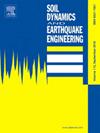Predictive model for assessing the nonlinear surface displacement and mechanical response of shallowly buried tunnels under dip-slip fault dislocation
IF 4.2
2区 工程技术
Q1 ENGINEERING, GEOLOGICAL
引用次数: 0
Abstract
The fault dislocation induces permanent ground surface displacement, leading to severe damage to tunnels. However, there is a notable scarcity of predictive models for nonlinear surface displacement and tunnel response under dip-slip fault dislocation. Previous analytical models have oversimplified surface displacement to a constant value. To this end, first, a predictive model for assessing the mechanical response of shallowly buried tunnels under dip-slip fault dislocation is established. Then, through a mathematical statistical analysis of field-measured data, a prediction method of nonlinear dip-slip surface displacement has been developed, and the nonlinear dip-slip surface displacement is introduced into the predictive model. The predictive model incorporates nonlinear surface displacement, fault zone width, and geometric nonlinearity, thereby markedly enhancing the accuracy of the calculation results. Secondly, the prediction model undergoes validation through experimental tests and numerical simulations, revealing a maximum error of 3.7 %. In contrast, neglecting nonlinear surface displacement can result in calculation errors as high as 517.5 %. Finally, the proposed predictive model is applied to conduct a parameter analysis, such as maximum surface displacement (Δdmax), dip angle (α), and fault zone width (WF). The results shown that the maximum axial force (Nmax), maximum shear force (Vzmax), and maximum bending moment (Mzmax) of the tunnel increase with the augmentation of Δdmax. For each incremental increase of 0.2 m in Δdmax, the Nmax, Vzmax, and Mzmax exhibit an approximate increase of 22.1 %–100.3 %. The Nmax and decreases with the increasing α, whereas both the Vzmax and the Mzmax increase as α rises. With each incremental increase of 10° in α, the Nmax diminishes by approximately 16.1 %–49.2 %, while both the Vzmax and Mzmax experience an increase ranging from about 4.6 % to 19.1 %. An increase in WF results in a decrease in the Vzmax and the Mzmax exerted on the tunnel. For every increment of 10 m in WF, both the Vzmax and Mzmax decrease by approximately 15.8 %–32.3 %.
求助全文
约1分钟内获得全文
求助全文
来源期刊

Soil Dynamics and Earthquake Engineering
工程技术-地球科学综合
CiteScore
7.50
自引率
15.00%
发文量
446
审稿时长
8 months
期刊介绍:
The journal aims to encourage and enhance the role of mechanics and other disciplines as they relate to earthquake engineering by providing opportunities for the publication of the work of applied mathematicians, engineers and other applied scientists involved in solving problems closely related to the field of earthquake engineering and geotechnical earthquake engineering.
Emphasis is placed on new concepts and techniques, but case histories will also be published if they enhance the presentation and understanding of new technical concepts.
 求助内容:
求助内容: 应助结果提醒方式:
应助结果提醒方式:


